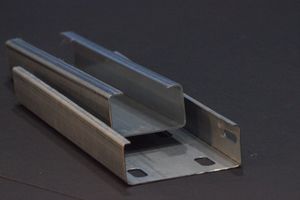Steel galvanized structure for solar panels
Alternative energy sources allow you to keep up with the times and protect the Earth from harmful effects. Solar rays have long been successfully used throughout the world to provide domestic and industrial needs. That is why the demand for solar panel frame is constantly increasing. This method of generating electricity can save a lot, especially if the area of solar system has a solid size. In addition, if you approach the issue of installation responsibly and choose a galvanized profile as the basis, such a design will last for decades in proper condition.
As a rule, manufacturers of solar panels are not engaged in the manufacture of mounts and supporting structures for them. Therefore, in this plan, you should look for a reliable team that will satisfy all needs and do the job flawlessly. It is on this that the efficiency of the chosen method of obtaining energy depends. Therefore, responsible customers are increasingly choosing structures made of thin-walled galvanized profiles for installing solar panels in their areas.
Characteristics and advantages of using a galvanized steel profile system
Installing an alternative energy source is quite expensive. However, you can save money on some processes, because the galvanized perforated mounting profile (C-solar profile) is quite inexpensive with maximum reliability and durability. In addition to economy, environmental friendliness and durability, which are significant criteria, galvanized steel profile has the following advantages:
● protective coating that guarantees resistance to corrosion and adverse effects of the environment and weather conditions;
● bent profiles are quite easy to install, they are connected without welding, so the assembly and installation process will take a minimum of time;
● Mounting traverse (S-solar profile), as well as other components made of such material, is as light as possible, but at the same time withstands regular heavy loads and exposure to natural elements.
Therefore, any structure based on a galvanized perforated mounting profile, provided that it is properly designed, manufactured and installed, will serve for decades without any problems.
Design options and their features
Ground support structures for photomodules can be single and double-column, with a portrait or landscape arrangement of solar panels in two, three rows or more. The design can be static or with a changeable angle of inclination of photomodules, the design can also be made in the form of a canopy.
For roof solar stations, systems for pitched and flat roofs are distinguished, located parallel to the slope and at a certain angle, as well as ballast systems.
The profile for solar panels (S-solar profile) produced by our company "LS Profi" has improved characteristics, therefore it is equally suitable for mounting various types of frames. Depending on the task, a project is created, the necessary dimensions and formats of structural elements are selected (profile type, thickness, perforation option, etc.). This criterion also affects the cost and complexity of the installation. However, the special perforated mounting profile (C-solar profile) remains reliable, no matter the conditions. And the installation process is as simple as possible due to the complete set of goods with fasteners for installation. The C-solar profile is used for objects such as rooftop solar systems and as girders and ties for ground structures for solar panels.
It has improved features:
● rigidity;
● lightness;
● resistant protective coating;
● variability of models.
In addition, the galvanized C-solar mounting profile has a lower cost, especially if you buy it directly from the manufacturer. When ordering solar panels, you need to think in advance about the frames for them. The mounting rail (S-solar profile) must be reliable and correspond to the specifics of the future object. When creating a project for a ground-based solar station, profiles are selected in accordance with the location and geological conditions of the site. When designing a roof solar power plant, profiles are selected in accordance with the type of roof and its angle of inclination, and taking into account the minimization of the load on the entire structure.

